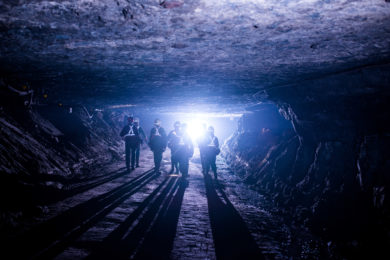A consortium of leading mining universities and mining companies in Europe has designed a dedicated training programme for mining professionals. “SafeDeepMining” is funded by EIT RawMaterials and aims to address the shortage of highly trained rock engineering personnel for deep mines that can deal effectively with the rock pressure problems jeopardising the extraction of deep mineral deposits.
Rock stability is one of the major challenges in European underground mining as the industry increasingly moves to extract ores from deeper levels. Experience shows, that despite progress made in rock mechanics and numerical modelling, there is still a considerable shortfall as far as application of rock mechanics principles in mine design and mining operations is concerned.
There are numerous examples of rock pressure related problems that have occurred which could have been avoided with good rock engineering. During 2019 alone, a number of seismic events in deep mines in Europe and beyond damaged infrastructure and caused fatalities.
During the past 50 years the majority of state controlled mining ventures have been closed and many of the leading mining research organisations have been either shut down or their activities heavily reduced. Many mining departments and programmes at European universities have been closed. This has resulted in the loss of skilled and experienced industry and university personnel in the field of rock mechanics.
There has also been a loss of expertise and infrastructure in the mining industry, government agencies concerned with supervision of mining activities, research organisations and universities. All of this means that new developments in rock engineering are not being applied or are being done so incompletely.
The stated objective of SafeDeepMining is to educate mining engineers, authority staff and personnel in consulting and at universities in state of the art rock engineering to assist European mining industry in dealing with rock pressure hazards threatening their future underground operations. For this reason, mining companies such as WOLFRAM, RHI Magnesita and KGHM Cuprum have already selected this programme to train their experts.
Felix Gaul, Mine Manager at WOLFRAM’s Mittersill mine in Austria, explains: “Mining engineers with a geotechnical background are hard to find in Europe, but still very important for underground mines, especially as they go deeper. The program gives engineers the valuable opportunity to update and upgrade their knowledge after some years of underground work experience to better understand and deal with the effects of rock pressure.”
To tailor the training for each participants requirements, SafeDeepMining is available in three versions:
1. A two-year professional training course “Advanced Rock Engineering Education for Deep Mining” (running 2019-2021 and 2021-2023)
2. A four week course “Rock Engineering for Deep Mining” (start in 2021)
3. Single Education Modules (12 modules existing, start date offered in Autumn 2020)
The course content can be broken down between the teaching institutions as follows:
- Fundamentals of rock mechanics (Silesian University of Technology, Gliwice, Poland),
- Numerical simulation models and techniques (Technische Universität Bergakademie Freiberg, Germany),
- Basics of geodetic, geophysical and geotechnical monitoring concepts and technologies (Geodata Group, Leoben, Austria),
- Rock fracturing around deep mining excavations and the different concepts of rock reinforcement and support (Montanuniversität Leoben, Austria),
- Rock mechanical laboratory testing (Technische Universität Bergakademie Freiberg, Germany),
- Numerical tools and analytical and empirical methods for mine design (Montanuniversität Leoben, Austria and Technische Universität Bergakademie Freiberg, Germany),
- Mining induced seismicity and rockburst mitigation concepts (Silesian University of Technology, Gliwice, Poland),
- Management of rockburst hazards in deep mines based on practical examples from Poland and South Africa (Silesian University of Technology, Gliwice, Poland),
- Cavity design based on analytical solutions in elastic and viscous ground conditions of salt mining (Clausthal University of Technology, Germany).










